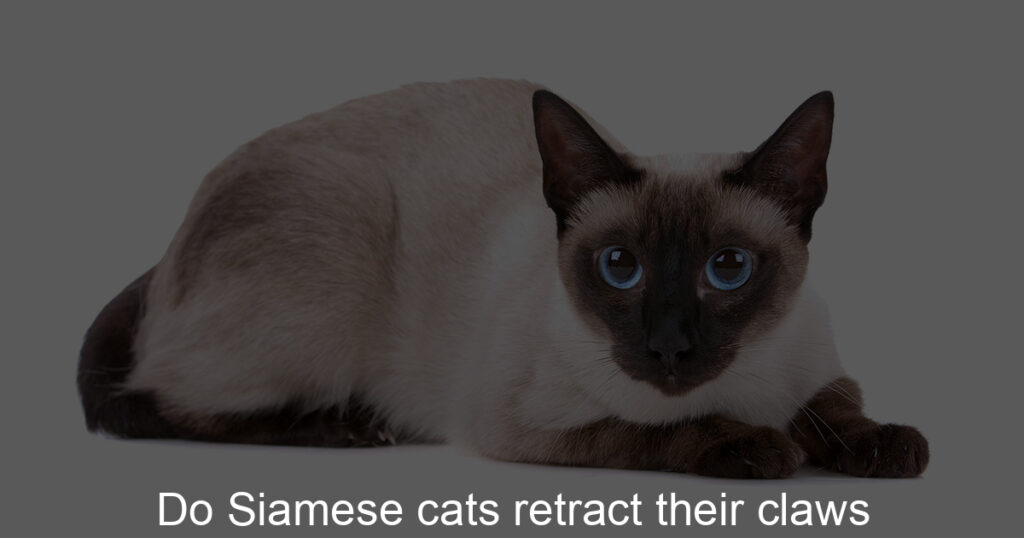Are you a cat lover, or specifically do you have a fascination with Siamese cats? Then you’ve come to the right place! There are many interesting facts about these beautiful creatures and today we’re going to delve into one of the more curious aspects of their anatomy – whether they retract their claws like other cats.
Not only will we cover this topic in-depth but also provide some insight into why it matters for those who are looking to adopt or bring home a Siamese companion. With that said, let’s jump right in and discover if these Siamies whiskers do vanish when necessary.
What is the nature of Siamese cats?
Siamese cats are one of the most recognizable cat breeds, thanks to their unique coloring, body shape, and personality. Siamese cats have a sleek and graceful appearance, with light fur that is cream-colored on their faces, legs, and tail while their bodies are colored in light browns, blues, and seal points.
Though they are beautiful to look at, that’s not all they have to offer! This breed is renowned for its intelligence and friendly personality.
The Siamese cat loves companionship from people and other animals so if you’re looking for an interactive pet to keep you entertained and snuggly then this is the breed for you! Whether playing fetch with them or singing them a lullaby before bedtime – a cuddle session with your very own little lap tiger will make sure you enjoy plenty of warm moments shared between man and beast.
Do Siamese cats scratch a lot?
Siamese cats tend to be quite active and love climbing and scratching, so their owners should make sure to give their felines plenty of outlets for these activities. However, training a Siamese cat can help keep their over-scratching tendencies in check.
Although it’s unlikely that you’ll get a Siamese kitty who doesn’t scratch at all, teaching them where it’s appropriate for them to do this – such as at a scratching post – might help redirect some of that energy away from your furniture and curtains. With the proper training, any dedicated pet parent should have no trouble finding ways to keep their Siamese companion out of trouble.
Do cats know when to retract their claws?
It seems cats have a built-in safety switch that determines when their claws should be extended and when they should be retracted.
Studies show that cats can sense pressure on their claws by applying very small forces to the surrounding layers of skin, so as soon as there is pressure put on them – such as when they are walking or playing around – they automatically retract their claws.
Furthermore, cats also can differentiate between types of surfaces, such as carpeting or wood floors, and will adjust to suit the surface. All in all, it appears that cats instinctively know just when to extend and retract their claws for maximum comfort and safety.
Do Siamese cats have retractable claws?
Siamese cats are both beautiful and brilliant, but have you ever wondered if they have any extra tricks up their sleeve, so to speak? The answer is yes! Siamese cats are one of the few cat breeds that have semi-retractable claws.
Although the claws don’t fully retract like some other cats such as bobcats, it is still a notable feature that adds to their charm. Unlike other cats whose claws stay out all of the time, Siamese cats can pull theirs in and out at will – often giving them greater control over when and how they use them.
Plus, as a bonus for their owners, this helps prevent furniture from being scratched or clawed unintentionally. So if you’re looking for an intelligent and unique feline companion – look no further than a Siamese cat!
Do Siamese claws retract?
It’s a common misconception that Siamese cats have retractable claws, but in reality, all cats have fixed claws. Retractability is a physiological trait shared among some mammals, including cats of the genus Felelis and certain other small felines.
While these species may possess this anatomical feature of retracting their claws upon demand, the general cat population does not–and this includes Siamese cats! Despite popular belief, there’s no secret button or ingenious way to make their claws disappear.
So there you have it – if your Siamese kitty has its claws out, they’re here to stay.
How does a cat retract its claws?
When it comes to the cat’s impressive claws, one of its most remarkable abilities is its capacity to retract them. This anatomical feature allows cats to move swiftly on floors and furniture without dealing with the discomfort associated with their sharp nails.
How does a cat accomplish this feat? It all comes down to the catapult effect – an elastic ligament that springs back as soon as pressure is applied during the retraction movement.
As soon as the cat takes away its foot, there’s a powerful elastic rebound that causes the claws to return to the sheath of fur. Pretty extraordinary!
Do cats’ claws stop retracting?
While cats’ claws often stay retracted most of the time, sometimes they don’t retract properly – especially in older cats. If this happens, it’s important to keep an eye on them because claws that remain fully extended can become ingrown and become painful for your feline friend.
Being proactive and having your cat’s claws trimmed regularly by a vet or groomer can help to prevent this from happening. Additionally, having a scratch post so that your cat can use their claws daily will also help keep their nails in healthy condition!
Does it hurt when cats retract their claws?
It may come as a surprise but if your cat is retracting its claws while sitting on you, it’s not hurting. That’s because the sheath containing the cat’s claws moves painlessly up and down the paw, acting like armor to protect the claws when they aren’t in use.
Despite this though, it is still advised to not keep your cat’s nails too long; that way, when they do come out, it won’t be painful for them (or you!). What’s more, if you get into a routine of trimming their nails regularly enough, they might tolerate (and even enjoy!) the process.
How do you train a cat to not claw things?
Training cats not to claw furniture and curtains is a challenge, but can be done with consistent patience and positive reinforcement. A key method to deter unwelcome scratching episodes is to provide cats with some environmental enrichment in form of an appropriate scratching post.
It should be tall, sturdy, and located near the furniture or curtain that your cat usually claws at. The post should also be covered with a material your cat likes as they tend to prefer specific textures.
Additionally, scratchers lined with open cardboard boxes or paper bags can often help cats direct their energy away from other objects in the house and redirect it toward their own designated scratcher!
As always, don’t forget to use treats and praise when you see good behavior so that your feline friend continues the good behavior on its own.
Why does my cat keep retracting her claws?
I often find myself wondering why my cat keeps retracting her claws. One reason could be that she is engaging in kneading as a sign of affection or comfort.
Kneading is when a cat puts its paws on something, presses it down with their paws, and then pulls them away, resulting in her retracting those claws. Kneading is an instinctive behavior for cats that helps them mark items as safe and comfortable.
It’s no wonder my cat does it around me; I’m sure she feels safe and loved when we’re together!
Conclusion
Overall, it’s clear that wild Siamese cats do possess retractable claws, allowing them to climb and catch prey. However, their domesticated counterparts don’t have the same advantage due to their usually less active lifestyles.
Even though our beloved Siamese cats may not be able to extend and retract their claws like they used to in the wild, they still manage to maintain a healthy lifestyle while receiving all the love we can give them as devoted pet owners.
We can always find ways to help keep our kitties active indoors so they get regular physical activity; playing with toys or running up and down the steps is enough for them to stay entertained. Additionally, making sure that nail trimming becomes part of your cat’s beauty routine would help keep those claws from turning into painful weapons of destruction.
So, go ahead and keep spoiling your feline friends with that extra dose of affection; keeping their claw length in check won’t take away from your bonding time!








